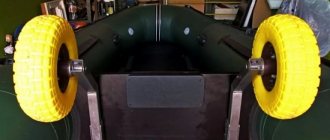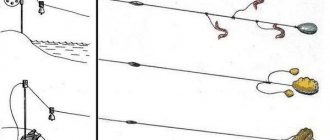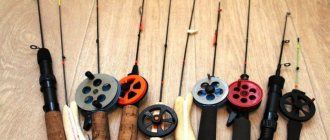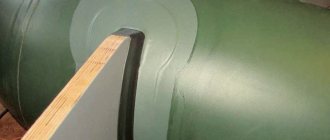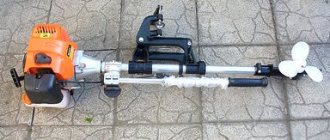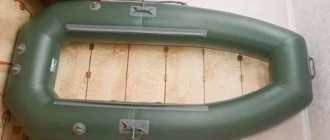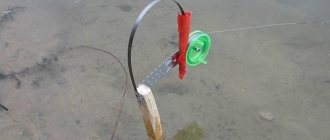When purchasing an inflatable boat longer than 320 centimeters, most likely, you will need to purchase transom wheels for installation on the hard transom of the boat. These inexpensive and compact devices greatly facilitate the transportation of the watercraft.
Why do you need transom wheels for a PVC boat?
Boats designed for 2 or more fishermen weigh more than 50 kg, and dragging them over sand, pebbles and stones is no longer safe and difficult. Therefore, transom wheels are provided for launching and lifting out of the water.
They are useful for transporting a boat in shallow water or for moving from one body of water to another, if it is not far away. For example, on cascades of lakes or to bypass impassable and dangerous places by land.
It is also convenient to use wheels if the location of the boat is close to the launch site. In this case, you don’t have to bleed it off or remove the equipment. They rolled it back, set it down, and the next time they lowered it into the water without any hassle. Comfortable!
Once again, what are transom wheels for?
Equipping a rubber, PVC or metal boat with transom wheels is designed to ensure ease of transportation of the vessel to the water. Considering that the total weight of a boat equipped with a motor can be quite substantial , it is very difficult for a fisherman alone to handle such a vessel.
Even if we assume that two fishermen are going fishing, a fair amount of effort will have to be spent to successfully handle the boat and at the same time maintain a good mood. With the invention of transom wheels, boat handling has become much easier . Additional equipment for the boat is quite inexpensive, the wheels are easy to install and are always ready for the necessary use.
The most interesting thing is that even if your boat is equipped with a motor, the installed wheels will not interfere with control on the water.
As is already clear from the name, the product is mounted on the rigid transom of the boat or, if the boat has a metal base, it is securely fixed to its hull. This simple device ensures that a lone fisherman does not experience any discomfort when launching the boat into the water and bringing it ashore.
The ability to quickly install wheels is greatly simplified due to the fact that special fasteners are installed once on the boat frame , which are reliable locks for the wheels. If necessary, they can also be quickly dismantled without removing the fasteners.
Rubber transom wheels
Rubber wheels are produced in two types: inflatable and cast.
Inflatable
With inflatable wheels, of course, there is more hassle. To begin with, they need to be pumped up and pumped up from time to time. Despite the fact that the rubber in the wheels is quite thick, the danger of a puncture always exists and then it will have to be repaired.
On the other hand, the wheels can be adjusted to the ground. If the boat is transported on sand, then the pressure in the wheels should be slightly lowered, their working area will expand and the ride will improve. On the contrary, increasing tire pressure improves driving performance on hard ground.
Cast
These wheels are much more practical, they will not puncture, they do not need to be inflated, bleed, or repaired. They are what they are and that's it. If you don’t necessarily need to drag your boat through forests, roads, or wide beaches, but prefer to ride it on water, then buy cast wheels. They are cheaper.
Folding and removable transom wheels
Anyone who needs boat wheels can buy them at numerous retail outlets. But at the same time you need to decide on the choice: they will be removable or folding.
Removable wheels are completely removed from the transom of the boat after use. They may cost a little less, but they will have to be reinstalled each time. Of course, this procedure will not take you much time, but it is still a certain inconvenience that you will have to endure constantly.
In the case of folding wheels, there is no such inconvenience. They recline and return to the desired position with one movement of the hand. But such a mechanism may fail. This usually happens in rare cases.
In addition to these differences, wheels can be:
- Twin - for boats with heavy and powerful engines;
- On an extended stand - for watercraft with an inflatable bottom;
- Standard - for boats of the simplest configuration.
Thus, it turns out that before you buy transom wheels you need to decide on your choice. And if you cannot do this, then you need to look at our website. With us you will not only be able to make a profitable purchase, but also find out which wheels are best suited for your boat.
Boat owners often have questions about their transportation. There is an opinion that sailing about 1 thousand kilometers by water transport is easier than moving it 100 meters on land. Advancements in technology have made this procedure easier as there is now a wide range of boat wheels available in the market.
Plastic transom wheels
Plastic wheels are made from:
- glass-filled polyamide;
- recycled polyethylene;
- propylene.
All these materials have increased strength, impact resistance and wear resistance. Do not react with aggressive media: petroleum products and sea salt.
The disadvantage of plastic transom wheels is that they are loaded on sandy, loose and swampy soils. When choosing wheels, give preference to the widest ones.
Kinds
Transport chassis are available in the following varieties:
Transformers KT-5
This model has a bolt design , where the chassis is mounted parallel to the transom of the boat in the folded position, which allows you to pack the inflatable craft without removing the chassis.
This design is very beneficial for the user: it is convenient, compact, and in the stowed position, the chassis is placed behind the transom and does not interfere with the control of the vessel.
Due to its functionality, the KT-5 design ensures comfortable movement of the boat by one person, where there is no need to seek outside help.
The material used for the base mounted on the transom of the vessel is steel with a thickness of 3 mm. For the wheel stand, a profile pipe with a system of grooves is used, which facilitates quick installation, removal or changing the position of the chassis from working to traveling.
The wheels of this type are equipped with an automatic spring mechanism, which allows you to move the boat over uneven surfaces (they do not form backlashes or rattles).
Automatic (KT-3N, KT-3NU)
This model is made of stainless steel, equipped with an automatic locking system, and is used for inflatable boats with a stationary transom, or for small boats with a rigid hull.
Advantages:
- High quality material and workmanship.
- Reliability.
- Great design.
- The optimal solution for moving a vessel over long distances.
- Ease of use (easily and simply brought into operating position and also assembled).
In the production process of automatic wheels of the KT series, laser cutting is used, and the seams are welded by argon welding, resulting in high precision and original appearance.
This design is capable of supporting a loaded boat weighing 120 kg.
Folding
The product is installed on the outer side of the transom , which allows you to easily fold the chassis both down and up. To fix the product, springs are used, located inside a stand made of stainless steel.
Not only the racks, but also other parts are made of stainless steel and are extremely durable, resistant to fresh (product KS-03) and sea (product KS-04) water.
Advantages:
Easy to remove and fold
and dismantle the product every time
Manual fastening method , do not interfere with the control of the vessel
There is an option for packing a deflated boat with wheels; it is used for all types of PVC inflatable boats; the maximum load on the wheels is 180 kg.
Tilt&Turn
The model is used to move an inflatable boat by one person over short distances.
Mounted to a plywood stationary transom using 4 bolts. Thanks to the rotating device, the position is adjusted both up and down due to the mounting pin.
To dismantle the accessory, simply remove the nut located on the side of the stand. Any car pump is suitable for inflating the chambers. The maximum load capacity of the chassis is 140 kg.
All parts are made of durable stainless steel, and the discs are made of premium plastic.
Types and models
There are two dominant types of transom wheel models in the boat equipment markets: folding and removable. Both have their advantages and disadvantages.
Folding
The main advantage of folding or folding transom wheels is that they do not need to be dismantled every time you lift and launch. They are permanently attached to the transom. While moving on the ground, the wheels are folded down and fixed; after launching the wheels, they can be unlocked and moved to the upper position.
For convenience, the design uses a spring mechanism that moves the wheels from one position to another.
With all the benefits of caster wheels, there are some problems that can ruin the mood. The design of the boat is such that in the upper position the wheels can interfere with the rotation of the engine, and the return mechanism can quickly fail, become clogged with sand, silt, etc. You will have to clean the spring to tilt the wheel to the optimal position when the latch snaps into place.
On a boat, every additional automation is a potential source of additional problems. Therefore, try to choose folding wheels without any automation.
Removable
Removable wheels do not have any mechanisms, they are practical and convenient, especially for those who have the opportunity not to take them with them, but to leave them in a camp, car, or country house. If you can’t leave them, you’ll have to take them with you.
It is advisable to install a small box for them near the transom with a lid. The lid can be used for cutting bait or as a table.
Usually, having secured the wheels to a specially installed mount on the transom, they are secured with a metal rod, which is secured against loss with a cable.
General concepts
Today the situation has changed radically, and such a device will certainly be found in the arsenal of an avid fisherman or outdoor enthusiast. For those who have never encountered the installation of wheels, it will be useful to get acquainted with the advantages and disadvantages of this device. Judging by the name, it becomes clear that the wheels are attached to the transom, a special insert at the stern that serves to mount the motor.
Rubber and PVC boats are equipped with a transom made of pressed plywood, so this part is sufficiently rigid and suitable for installing additional equipment.
Transom wheels for PVC boats allow you to conveniently transport the boat from one place to another. Despite its compactness and functionality, this device is not used on long trips. This is the main disadvantage of transom wheels. There are several reasons for this:
- The absence of rolling bearings reduces the service life of the wheel; moreover, the bushings are not designed to rotate at high speed.
- The narrow rut makes the boat extremely rolly. Its overturning on the highway is fraught with an emergency situation.
- The low position of the boat above the ground increases the risk of damage to the material from objects that may lie on the road.
The above disadvantages do not at all mean that the device in question is a useless device. Often fishermen find themselves in a situation where moving the boat just a few meters is considered an important necessity and they simply cannot do without quick-release wheels.
To confirm the above, consider an elementary example. An ordinary PVC boat weighs about 50-60 kg. If it also has a motor installed, then another 25-30 kg should be added here. Equipment consisting of a fuel tank, anchor, and gear will add another 30 kg. As a result, moving a boat with a total weight of 120-130 kg from a car to a body of water will be very problematic.
It's not just about the force applied, but also about the likelihood of damage to the bottom from branches or stones. The best option is to install transom wheels, which can then be quickly removed or folded.
How to choose the right transom wheels
The choice should begin by determining the weight of your boat when fully equipped.
Let's calculate the weight of a loaded boat using the example of the popular CAYMAN 330 model:
- boat weight – 52 kg;
- Yamaha motor weight 15 – 36 kg;
- gasoline tank – 24 kg;
- 2 anchors – 12kg;
- food, bait, fishing rods, tools, fish... – 50 kg;
- water -10 kg.
The total came out to 184 kg. This means that wheels must be selected with a load capacity of at least 200 kg. If you have to transport a boat through sand and mud, then choose not only wide wheels, but also with the maximum possible diameter. The wheels will dig into the ground less.
Wheels can be with ball bearings and plain bearings. The last option is a bushing with an axle inserted into it. These bearings have high friction, especially under heavy load. If sand gets into them, the wheel can completely jam. But they are cheap.
Wheels with ball bearings do not have these disadvantages and have an excellent ride, but they are more expensive.
Basic principles for choosing wheels for a boat
In order to avoid becoming a victim of deception, you must adhere to some simple rules when purchasing transom wheels. And the very first rule is that the weight of your boat matches the maximum permissible load that these wheels can withstand. It is best, despite the persuasion of some sellers, to always buy such a product with a margin of safety. This will insure you against emergency situations.
Next, you should pay attention to the shape of the racks of the wheels you have chosen. It is best to choose straight racks. They are the most reliable. Of course, you can be offered transom wheels, or you can buy them with curved racks. But such racks have an increased tendency to deform.
It should also be noted that the metal of the boat wheel stands should not be exposed to rust. Otherwise, the aquatic environment will quickly have its negative impact.
When purchasing wheels, you need to pay special attention to the tires. They can be all-rubber and vacuum (as in a regular car). If you don't plan on moving your boat over rocks or uneven surfaces, then solid tires are what you need.
But for sandy or rocky surfaces, only vacuum tires are suitable. With them you will not feel any unevenness and the process of moving the boat will be much easier. They also do not sink into sand or soft soil.
Installing transom wheels on a PVC boat
Installing mounts for transom wheels can be done by every man who has held a drill in his hands at least once in his life. Please note that not all wheels are sold with mounting hardware, so you will need to purchase it separately.
- Wheel mounts are installed on the boat in assembled and inflated condition. The boat needs to be raised for convenience. Inspect the place at what level the floorplate is located in relation to the transom, so as not to accidentally hit it with a drill. Also, do not touch the scarf and nameplates.
- Next, mark the center line. To do this, attach the wheel together with the mount to the transom as close as possible to the boat’s cylinder. Mark the locations for fastenings on the center line. It is advisable that the height of the lower mount should not be lower than 100 mm from the bottom of the transom. Just in case, after marking, attach the wheel mount again, if everything is in order, then continue.
- We drill holes in the marked places. Use a square to ensure that they are strictly perpendicular to the plane of the transom, otherwise the bolts will twist at the corners, which is not desirable.
- Now generously lubricate the holes, fasteners and mounting plates with silicone sealant. We install the fasteners in place and tightly twist the bolts and nuts. Having previously installed a pair of washers on the bolts on each side of the transom: silicone and metal. Naturally, silicone ones are on the transom side. Ready!
Installation recommendations
Attaching transom wheels to a PVC boat is a very responsible process, because... If installed incorrectly, the hull of the boat can be seriously damaged. Therefore, upon purchase, instructions for installing transom wheels on a PVC boat are supplied with the chassis. The nuances of installation depend on the components of a particular chassis model, but a number of general recommendations can be identified. They are suitable for those who made the wheels themselves or lost the instructions from a purchased product.
So, we present to your attention useful tips on how to install transom wheels on a PVC boat so that they are comfortable and durable.
- Trying on fastenings for an inflated boat. Attach the chassis parts and make sure that the floorplates, gusset, nameplates, etc. will not be affected during installation.
- Marking connections. The fasteners are applied to the transom, then the side edges and bottom markings are marked with a pencil. It is recommended that the gap from the lower transom part to the lower edge of the mount be at least 10 cm.
- Drilling holes. It is carried out strictly at the designated points. For greater accuracy, you can additionally use a square.
- Treating the holes and fastening parts with sealant. Necessary to protect the transom from water ingress, as well as corrosion and rotting of the board. In addition, the sealant increases bond strength.
- Installation of fasteners. The mounting plate is tightened with bolts with pre-installed washers (silicone ones are used at the transom, and metal ones on the outside). It is recommended to tighten the nuts not quickly, but one by one and smoothly, carefully adjusting the required condition of the fasteners.
- Wheel installation. The frame under the wheel is mounted on the mount, then the chassis fixing bolt is inserted and, finally, the wheel itself is installed, secured with a nut.
The chassis is mounted one at a time and the steps for installing the second wheel are completely similar to the diagram shown. In general, fastening the wheels, depending on the skills and experience of the owner, takes 1-2 hours.
Views: 2,495
Transporting a PVC boat on transom wheels
Transporting a boat on transom wheels is not difficult. You go down with your bow up, and you lift up with your stern down.
Try to avoid areas with soft, loose soil: mud, sand, silt. It’s hard on yourself and the wheels wear out more.
Do not use transom wheels to transport boats as trailers to a vehicle. They will not withstand a long journey. But it’s hard to even imagine how the inspector will like it. The wheels and fastenings are designed to transport the boat only over short distances and only with manual human traction.
Types of transom wheels
Which transom wheels are best to choose for a PVC boat? They are divided into 4 main groups and differ in installation method and design.
Semi-automatic changeover
They can take a working or transport position due to the installed reversible spring-loaded mechanism.
When the boat moves through the water, the wheels easily lift up and lock onto the sides of the motor. To remove it, you need to unscrew the nut and remove the bolt.
Not everyone is happy with the wheels being raised up when the craft moves through the water. This position may cause interference if a fish finder is attached to the transom. As a result, there is little space left.
In what cases do you choose semi-automatic reversible wheels for an inflatable boat ? If you need to take them onto the ship, then swim to the shore, pull out the boat and take them to the desired place.
Stiletto heels for NDND
Fixation to the transom is carried out using two studs. There are two positions: functional and transport. The studs are installed in pre-prepared holes, then the wheels are put on them and secured with cotter pins. In the transport position, the chassis is raised.
How does this variety differ from the changeover type? In this case, more work will have to be done to move the wheels to the upper position. You will need to remove the cotter pins, remove the wheels, then turn them over, and then put them back on and fix them.
Quick release transom wheels
They take one position - to move the boat along the shore. After it is delivered to the site, they easily snap off the flange. Then you can throw them into the boat or put them on the shore.
Preference is given to this option precisely because of the convenient and quick removal of the wheels. But there is no point in taking them with you on the water. It’s easier to leave it on the shore and attach it after mooring.
Transom wheels with clamps
What is a clamp? As you know, the structure consists of a wheel, a bracket and a stand. In this case, instead of a bracket, a clamp is used. It makes the wheels removable, and you can install and dismantle them in a matter of seconds. You just need to loosen the fastening, and the stand can be easily removed from the transom.
There is no need to drill holes for installation. This is the main advantage of this type of boat wheels.
The model is intended primarily for PVC payol type boats. It is these watercraft that rest on the wheel brackets with the entire weight of the transom board. Why can’t we use mechanisms with clamps for models with LPND (low pressure inflatable bottom)? The lower part of the transom is not rigid and extends beyond the boat. Therefore, there is no possibility of installation on such a structure.
Photo of transom wheels for a boat
Read here Steering console for a boat - a review of the best models and installation tips for different types of boats (100 photos and videos)
Help the project, share on social networks
0
